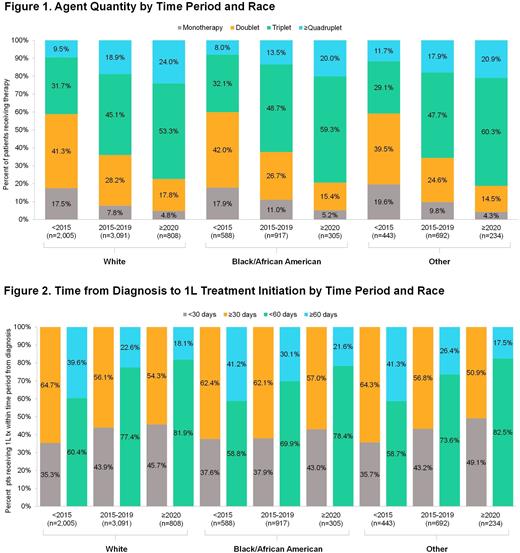Abstract
Introduction: Published studies have shown significant racial disparities in MM incidence, Tx patterns, and outcomes. Black/African American (AA) pts have both higher MM incidence and corresponding mortality than White (W) pts. AA pts present at younger median age yet are less likely to be enrolled in clinical trials of novel therapeutic agents or undergo stem cell transplant (SCT). However, in studies performed in equal access situations, AA have comparable or better overall survival, highlighting the importance of improved access to healthcare. Using a large, real-world database we explored how tx patterns and clinical characteristics differ between racial groups and have evolved over a 10-y period.
Methods: This retrospective observational study examined MM pts identified in the Flatiron Health from 1 Jan 2011 to 31 Jan 2022. This US-based real-world database collects electronic health records data from community practices (~80%) and academic centers (~20%). Pts aged ≥ 18 y, with a documented MM diagnosis (first diagnosis = index date) between 1 Jan 2011 and 31 Oct 2021 who received at least first-line (1L) systemic therapy and had ≥ 3 mo of follow-up were included. Descriptive statistics were used for all continuous, categorical, and binary study variables.
Results: A total of 9083 pts were analyzed: 65% (n = 5904) were W; 20% (n = 1810) were AA; 15% (n = 1369) were 'Other race' (O). These proportions did not vary by year of diagnosis. Before 2015, 33% (n = 3036) of all pts were diagnosed with MM, 52% (n = 4700) diagnosed by 2015-2019, and 15% (n = 1347) diagnosed ≥ 2020. Median age at index was 70, 66, and 68 y in W, AA, and O pts, respectively. A Charlson Comorbidity Index (CCI) score ≥ 1 at index was reported in 9.3% of pts overall; the proportion of pts with CCI ≥ 1 increased over time: W 4.8% (< 2015), 10.2% (2015-2019), and 14.2% (≥ 2020); AA 5.3% (< 2015), 12.4% (2015-2019), and 16.7% (≥ 2020); and O 4.7% (< 2015), 11.3% (2015-2019), and 10.3% (≥ 2020). At diagnosis hypercalcemia was rare (4.2% overall), without appreciable differences by race. Renal insufficiency (creatinine clearance > 2 µmol/L) was seen in 15.9% of pts overall and differed by race: W 15.1%, AA 19.2%, and O 15.2%; this was stable across study periods. Overall 37.9% of pts had anemia; W 35.5%, AA 44.9%, and O 39.8%. Bone lesions, identified using International Classification of Diseases codes, were rare (1.1% overall).
Overall, 30.4% of pts received SCT and median time from index date to SCT was 8 mo (232 d). Across race cohorts, 31.8%, 28.7%, and 26.8% of W, AA, and O pts, respectively, received SCT and median time to SCT was 7.4, 8.4, and 8.0 mo for W, AA, and O pts, respectively. The proportion of pts who had triplet or quadruplet 1L regimens was similar across race cohorts (W 58.1%; AA 58.0%; and O 60.3%). While the percentage of pts receiving triplet or quadruplet regimens increased over time for all races and were similar, W pts generally received quadruplet therapy more often than AA and O pts (Figure 1). Before 2015, the most common 1L regimen was lenalidomide + dexamethasone (Rd) across all races (W 23.8%; AA 26.2%; and O 19.4%), and Rd + bortezomib was the most common 1L regimen from 2015 to Jan 31, 2022. The average time from index date to start of 1L therapy was 153, 173, and 170 d for W, AA, and O pts, respectively, indicating a longer time to tx for AA and O pts. Time from diagnosis to 1L tx shortened over time for all races. In ≥ 2020 the percentages of pts treated within 1 mo of diagnosis were W 45.7%; AA 43.0%; and O 49.1% (Figure 2). Average duration of 1L therapy was 13, 13, and 12 mo for W, AA, and O pts, respectively.
Conclusion: This real-world study presents pt characteristics and tx patterns using the Flatiron database. Compared with W pts, AA pts were more likely to present with anemia and renal insufficiency, and experienced higher CCI scores over time, possibly indicating later diagnosis. By including pts who received at least 1L therapy, this group of pts analyzed likely represents an equal access setting, despite lower rates of private insurance and delayed tx onset among AA. Thus, in contrast to prior studies, AA and W pts were found to have similar tx patterns, including access to highly active combination therapy and SCT use. This indicates that prior disparities in the availability of novel agents can be overcome with appropriate resourcing, and although limited differences in tx were identified by race, further analysis exploring disparities in access to 1L therapy are needed.
Disclosures
Saunders:BMS: Current Employment, Current equity holder in publicly-traded company. Slaff:Merck (Spouse): Current Employment; Bristol Myers Squibb: Current Employment, Current equity holder in publicly-traded company. Subbiah:Bristol Myers Squibb: Current Employment, Current equity holder in publicly-traded company. Gu:Bristol Myers Squibb: Current Employment, Current equity holder in publicly-traded company. Rosenberg:Takeda: Other: Institutional Research; Kangpu: Other: Institutional Research; Bristol Myers Squib: Research Funding; Adaptive: Consultancy; Janssen, Takeda: Speakers Bureau.
Author notes
Asterisk with author names denotes non-ASH members.


